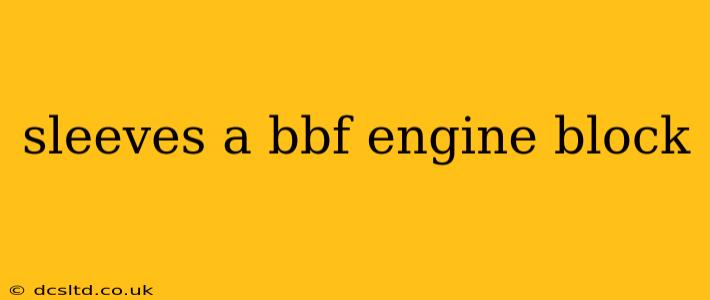The Ford 429/460 big-block engine (BBF), a legendary powerhouse, often requires significant attention as it ages. One common issue, particularly for high-performance builds or engines subjected to wear and tear, is cylinder wall damage. This is where sleeving comes in. Sleeving a BBF engine block involves installing new, stronger cylinder liners within the existing block, effectively revitalizing the engine's lifespan and performance. This guide explores the intricacies of sleeving a BBF engine block, addressing common questions and considerations.
What is Sleeving an Engine Block?
Sleeving is a repair process that replaces worn or damaged cylinder walls with precision-engineered liners. These liners, typically made from durable materials like cast iron or nickel-silicon carbide, are inserted into the block's existing cylinder bores. This process restores the cylinders to their original dimensions and surface finish, providing a foundation for a reliable rebuild. For a BBF, sleeving is often a necessity when cylinder walls are scored, excessively worn, or damaged beyond repair through honing or other less invasive methods.
Why Sleeve a BBF Engine Block?
Several reasons necessitate sleeving a BBF block:
- Significant Cylinder Wear: Years of use, especially under high-performance conditions, can cause excessive wear on the cylinder walls. Sleeving provides a fresh, precisely sized surface for pistons to operate on.
- Cylinder Damage: Overheating, detonation, or foreign object intrusion can damage the cylinder walls, creating scoring or other imperfections. Sleeving rectifies this damage, creating a smooth, undamaged surface.
- Increased Bore Size: Sleeving allows for increasing the bore size of the cylinders, leading to a larger displacement and increased power output. This is a popular modification in high-performance applications.
- Material Upgrade: The new liners can be made of a more durable material than the original cylinder walls, enhancing the engine's longevity and resistance to wear.
What are the Different Types of Sleeves?
Several types of sleeves exist, each with its own advantages and disadvantages:
- Dry-type Sleeves: These sleeves rely on a tight interference fit within the block, requiring precise machining. They offer excellent strength and durability.
- Wet-type Sleeves: These sleeves have a coolant passage between the sleeve and the block, allowing for better heat dissipation. They are generally used when increased cooling is required.
How Much Does Sleeving a BBF Engine Block Cost?
The cost of sleeving a BBF engine block varies significantly depending on several factors:
- Type of Sleeves: Dry-type sleeves are generally less expensive than wet-type sleeves.
- Labor Costs: The cost of labor can vary greatly depending on the mechanic's experience and location.
- Block Preparation: The amount of machining required to prepare the block for sleeves can influence the overall cost.
Can I Sleeve a BBF Block Myself?
Sleeving an engine block is a complex process that requires specialized tools, expertise, and precision. Attempting this process without the necessary skills and equipment can lead to irreparable damage to the engine block. It's strongly recommended to entrust this task to a qualified engine machinist.
What are the Benefits of Sleeving a BBF Block?
The benefits are numerous:
- Engine Longevity: Sleeving significantly extends the engine's lifespan.
- Improved Performance: Sleeving allows for potential bore size increases and enhanced power output.
- Reliability: A sleeved block offers superior reliability compared to a block with damaged cylinders.
- Cost-Effectiveness: In many cases, sleeving is a more cost-effective solution than replacing the entire engine block.
Conclusion
Sleeving a BBF engine block is a specialized procedure offering significant advantages for restoring or enhancing performance. The process demands precision and expertise, making it crucial to employ qualified professionals for optimal results. Understanding the various factors involved, from sleeve types to costs, ensures informed decision-making when considering this essential engine repair or modification.
